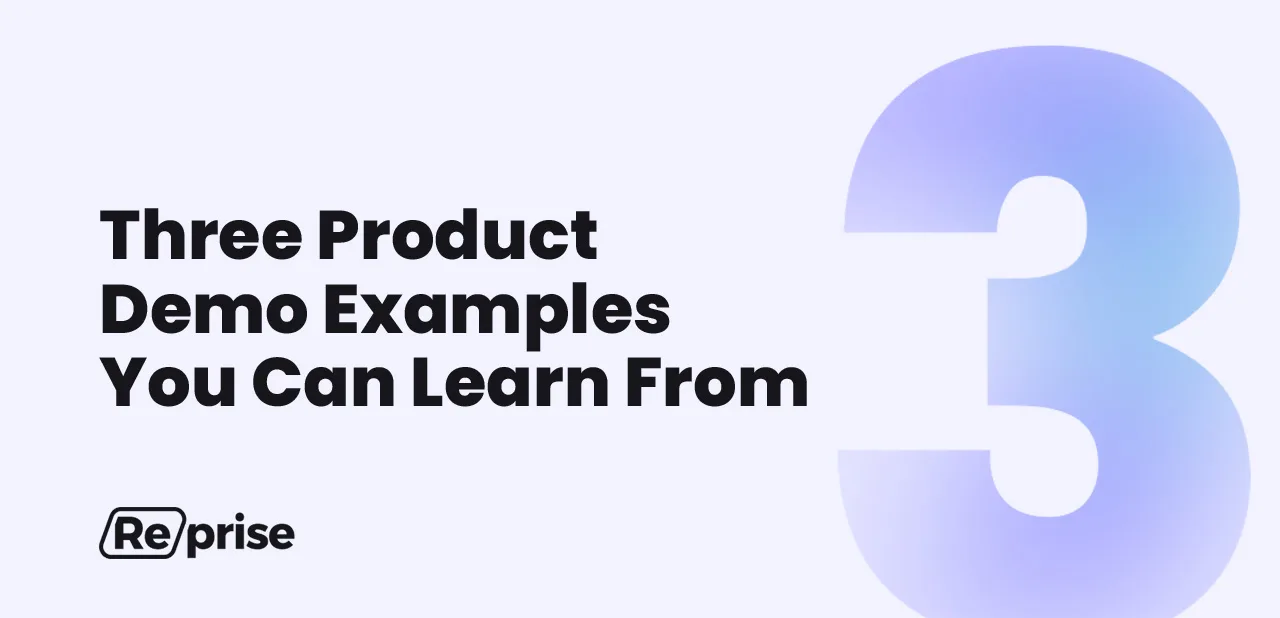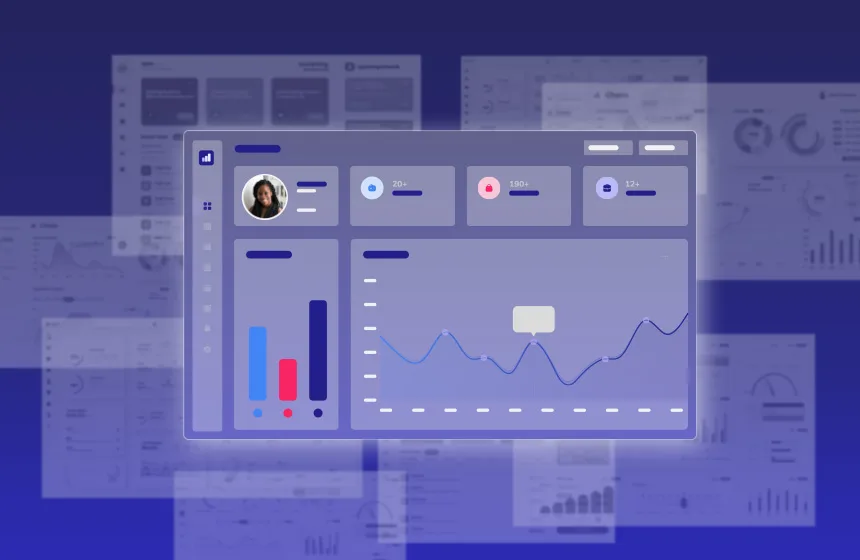Three Product Demo Examples You Can Learn From

April 23, 2025
Table of Contents
For enterprise SaaS companies in 2025, product demos have evolved into an essential sales, marketing, and customer engagement strategy. This blog explores best practices, types, and benefits of product demos, along with some of our favorite examples to learn from — offering a comprehensive guide for businesses looking to leverage this powerful tool.
What is a Product Demo?
An interactive product demo is designed to showcase the functionalities, features, and benefits of a product. Product demos play an important role throughout the enterprise buying cycle, as well as in the customer onboarding process. They can engage potential customers, allowing them to experience the product first-hand — without the effort associated with a SaaS free trial or freemium product. As B2B buyers’ attention becomes more fragmented, product demos offer a tangible way to capture interest and drive decision-making.
Benefits of Creating a Product Demo
Creating an interactive product demo offers many advantages. From increasing engagement to streamlining the sales process, these demos not only capture the attention of potential customers, but also bring operational efficiencies to your team and drive business growth.
Communicating Value Effectively
Through a product demo, you can visually and interactively showcase your product’s value to potential customers. Moving beyond mere text or static visuals, a demo vividly demonstrates the product in action, highlighting its benefits and functionality. This direct and tangible portrayal of value helps potential buyers understand how your product can fulfill their requirements.
Targeting Customer Needs
Product demos serve as an effective tool to directly address the unique challenges and pain points of potential customers. Demonstrating your product’s ability to resolve real-world issues conveys an understanding of the customer’s needs, offering a tailored solution. This personalized strategy enhances your product’s relevance and boosts the chances of customer conversion.
Improving Lead Generation and Pipeline Conversion
Leveraging demos at the top of the funnel can capture conversions at higher rates. Plus, using demos earlier in the buying process enables sales reps to tailor demos to prospects’ specific needs, which increases relevance — along with the likelihood of converting them to pipeline.
Accelerating Sales Cycles
Demos enable self-service buyer education, allowing prospects to qualify in or out of a sales process early on, without consuming the sales team’s resources. Because buyers come to demos with a better understanding of how the products can solve their needs, and because buyers are more purchase-ready by the time they reach sales, the sales cycle can be drastically shortened. Additionally, interactive demo assets created allow champions to sell internally without needing every stakeholder to participate in each live call or demo.
Tips for Crafting an Effective Product Demo
Creating an effective product demo is an art that requires a deep understanding of your audience, concise content, and a focus on key features and benefits. This section will explore essential strategies for developing a product demo that resonates with your target market. From the importance of audience analysis and the power of simplicity to highlighting real-life applications, these guidelines will ensure your demo not only informs but also inspires potential customers.
Understand Your Audience
Understanding your target audience is a cornerstone of creating an effective product demo. Collect data and conduct surveys to gather vital information about potential customers, including their preferences and concerns. Consider the buyer persona as you tailor your product demo to their specific needs and interests.
Keep it Short and Simple
The mantra for effective product demos is to keep it short and simple. The goal is capturing and retaining the attention of potential customers. It’s important to concisely present key information and benefits, ensuring that the demo doesn’t overwhelm viewers.
Focus on Key Features and Highlights
In a product demo, the focus should be on key features and highlights. This requires creating a script and storyboard that effectively spotlight these aspects, using interactive elements to enhance clarity and engagement. Emphasizing these key features ensures the product is presented in the most impactful way possible.
Showcase the Benefits
A successful product demonstration can streamline sales processes, offering tangible evidence of the product’s efficacy, and allowing for direct feedback from potential customers. It enables prospective customers to experience what product ownership would be like before the sale. In a committee decision, a demo can help champions to effectively convey your product story and close the deal. Product demo software can help teams highlight product benefits to enhance the overall effectiveness of the sales strategy.
Share Real-Life Stories or Examples
Incorporating real-life stories or examples in a product demo significantly engages potential customers and builds trust. Showcasing real customers and their experiences makes the product more relatable and trustworthy, creating a stronger connection with the audience, building social proof, and reinforcing the value of the product.
Types of Demos to Consider
Product demos are versatile tools that play a crucial role at various stages of the enterprise buying cycle, from initial interest to final decision-making. Whether it’s custom demos designed for targeted user engagement, guided tutorials for user education, or interactive demos for immersive experience, these variations cater to the evolving needs of potential customers throughout their journey.
Product Walkthroughs
Research by Forrester indicates that 60% of purchasers visit a vendor’s website before agreeing to a sales meeting. Product walkthroughs provide an excellent opportunity for buyers to engage directly with a product’s main features and advantages. These demos, in contrast to static product tours, offer potential customers the chance to explore a product more interactively and meaningfully. They create immersive experiences that not only encourage sign-ups but also familiarize customers with the functionalities of SaaS tools. A number of businesses incorporate product walkthroughs into their homepages or product marketing initiatives, catering to prospects who prefer to evaluate products independently.
Live Sales Demos
When prospects are prepared to engage with sales teams, custom, live demos become a crucial factor in finalizing a sale. A Bain & Co. study reveals that demos are a key source of information for buyers in the decision-making stage, with 72% of participants indicating that their selected vendors stood out due to effective demos and trials. Personalized demos that directly address individual pain points and challenges add a level of customization to the sales process. These demos are usually conducted after a marketing interaction or an initial discovery call. By enabling sales teams to tailor their approach, live demos help prospects clearly see how the product can meet their unique needs or fit into their specific operational context.
Sandbox Environment
A sandbox environment is a controlled setting in which a demo is conducted. It can include simulated scenarios, data, and user interactions, creating a realistic demonstration experience. Some sandbox environments rely on live production environments, which can lead to challenges if there are demo failures such as technical issues or a failure to anonymize customer data. It is better to choose a demo environment that is separate from a product’s backend to avoid these failures.
Best Practices for Creating a Successful Product Demo
Crafting a successful product demo is not just about showcasing a product’s features; it’s about creating a narrative that resonates with your audience and fulfills specific business objectives. In this section, we cover a few best practices to ensure your product demo hits the mark. From setting clear objectives to using storytelling techniques that engage potential customers, these guidelines are designed to create an effective demo that is not only informative but also persuasive and memorable. Here’s how you can maximize the impact of your product demos.
Determine Your Objectives Ahead of Time
Before creating the product demo, it’s crucial to define your objectives clearly. The purpose of the demo can vary widely — it might be aimed at generating leads, educating potential customers about the product, or highlighting specific features. By identifying these goals early on, you can tailor the content and approach of the demo to align with these objectives. For instance, if the goal is lead generation, the demo might focus more on engaging content and strong calls-to-action. If it’s about customer education, key elements might delve deeper into the functionalities and use cases of the product. Proper planning ensures that every aspect of the demo, from its length to its level of detail, is optimized for its intended outcome.
Tell a Story That Resonates With Viewers
Storytelling is a powerful tool in the arsenal of product demos. By weaving a narrative that focuses on the challenges and pain points that your product addresses, you create a demo that is not just informative but also relatable and engaging. This story-centric approach helps potential customers visualize how the product fits into their own lives or helps with specific problem-solving. It’s not just about listing features; it’s about illustrating the journey from problem to solution. For instance, a demo could start by depicting a common issue that the audience faces, gradually introducing the product as a solution, and culminating in a showcase of how work improves with the product. Such storytelling not only makes the demo more memorable but also strengthens the emotional connection between the customer and the product.
Three Product Demo Examples to Learn From
The three examples below show how Reprise-powered demos provide prospective customers with a firsthand product experience, communicating the value of even the most complex products. These teams have leveraged demos to accelerate their sales cycles, improve the efficiency of their sales operations, and even keep customers informed of new products or features as they launch.
1. Hireology Product Tours Accelerate Sales Cycles by 50%
HR platform provider Hireology saw an opportunity to modernize their sales motion. With Reprise product tours, Hireology prospects experience the product first-hand and go-to-market processes are more consistent and efficient.
At the top of the funnel, Hireology uses the product tours on their website to engage prospects with self-service marketing content, allowing them to self-qualify in or out of a sales process early on – without consuming the sales team’s cycles.
Mid-funnel, in addition to presenting live demos, sales teams share guided product tours as leave-behinds to highlight specific features for different audiences and their unique needs. They extend Hireology’s reach to a broader circle outside of the core buying committee in order to create wider consensus without needing every stakeholder to participate in every live call or demo. And they’re easy to build – Hireology’s eight feature-specific leave-behinds were created within a single month.
Across the funnel, every demo makes a bigger impact with consistent delivery and tight messaging. As a result, Hireology has seen opportunities involving product tours close 50% faster than those where product tours were not utilized.
See the Hireology product tour here.
2. Pendo Product Tours Drive Increased Website Conversions
Pendo – which provides a product experience platform supporting enterprise customers like Morgan Stanley, Verizon Connect, and Cision – needed an easier way to showcase their product and its ability to solve customer problems than spinning up trials. Using Reprise, Pendo’s marketing team built a library of product tours that offer prospects a way to experience the product independently.
Their product tour library has been a successful driver of website conversions, serving more than 200,000 views. The Pendo marketing team also used a product tour to support a recent product launch, which proved to be a top-performing call to action.
In addition to helping marketing make a bigger impact, product tours have improved Pendo’s sales team efficiency. Prospects take tours before they’re ready for a sales conversation, so they’re more qualified once they do engage.
See one of Pendo’s product tours here.
3. Digital River Empowers Sellers to Demo “Instantly and at Will”
Digital River is an e-commerce platform that helps organizations grow internationally while removing risk and complexity. Their sales team historically relied on sales engineers to set up demo environments before each live demo, which required extra effort and made it prohibitive to jump into a demo on the first call. This process introduced the risk of losing a prospect between the first call and second.
Reprise has evolved the way Digital River demos. Sales reps can independently deliver demos, without worrying about the stability of the demo environment. And they can be adaptive, showing aspects of the product a customer will care about most based on real-time feedback. This real-time feedback helps to qualify whether the solution is relevant earlier in sales cycles, improving efficiency.
With Digital River’s live demo platform, prospects are qualified earlier on, and sales engineers get time back that had been previously spent creating demo environments and supporting early sales calls. The customer experience is also better, because prospects get to see the product sooner, and the demo they see is catered in real time to their needs and interests.
See one of Digital River’s demos here.
Wrapping up
Product demos in 2025 are more than just presentations; they are immersive experiences that connect customers with products in meaningful ways. By understanding the audience, keeping content concise, focusing on key features, showcasing benefits, and sharing real-life stories, businesses can create demos that not only inform but also inspire. Custom demos, guided tutorials, and interactive demos offer various approaches to suit different products and audiences. Best practices like setting clear objectives and using storytelling further enhance the impact of these demos. As the market evolves, product demos will remain a vital tool for both sales and customer engagement alike.





